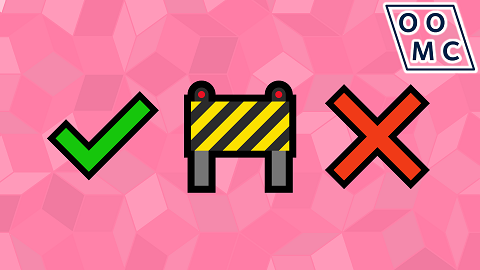Season 9 Episode 5
Where's the boundary between truth and falsehood? What would it mean to be near that boundary? In this episode, we try to explore the space of all maths facts.

Further Reading
Lenses
There was a brief to our Winter Puzzles episode for some discussion of an approach to problem-solving where you look at limited information about the problem, as if you're looking through a coloured “lens”. You can find out more from the episode, or by looking through the further reading notes.
Integral
The question from the end of the episode was
$$ \text{Prove that}\quad \int_0^1 \frac{x}{1+x^2}\,\mathrm{d}x \leq \frac{3}{8} $$
A good trick for proving inequalities of the form \(A<B\) is to find some quantity \( C \) such that \(A<C\) and \(C<B\). Don’t give up if your first choice of \(C\) turns out to do one of those but not the other!
Where’s the truth boundary?
Here are a couple more examples of facts that you could try to prove, and then try to explore. If the fact is true, can you strengthen it, either by assuming less (weaker hypothesis), or proving more (stronger conclusion), or both? If it's false, can you salvage anything from the wreckage?
Quick vocabulary note for this one; a Pythagorean triple is a set of three integers \((a,b,c)\) such that \(a^2+b^2=c^2\).
"If \(n\) is an odd number that isn't prime, then there is a Pythagorean triple where one of the integers is \(n\)."
"If \(p\) and \(q\) and \(r\) are whole numbers and \(pq\) is a multiple of \(r\), then either \(p\) is a multiple of \(r\) or \(q\) is a multiple of \(r\)."
False implies all
The notation “A ⇒ B”, pronounced “A implies B”, is defined to mean “B OR NOT(A)”. Sometimes people are surprised that this includes NOT(A), because they feel that if A is false, then it shouldn’t “imply” anything. But if you think like that, then there’s a strange consequence; if you insist that A has to be true too, then what you actually have is just “both A and B”. It would be odd to define “A ⇒ B” to be the same thing as “both A and B”! Maybe the response to that is “OK, perhaps A can be false, but only if B is false as well”. That’s logically equivalent to "both or neither", usually written “A ⇔ B”, and otherwise known as XNOR. What a mess! Maybe we should start from scratch and see what we can build?
Activity: a “logic gate” takes two inputs that are separately either TRUE or FALSE, and it returns either TRUE or FALSE for each combination of inputs. Explain why there are exactly 16 possible logic gates. Draw truth tables for all of them (you can find an example of a truth table here). Describe the behaviour of each (e.g. one of your logic gates might behave like “ignores A, contradicts B”). Decide which of your logic gates represents “A and B”, “A ⇒ B”, “B ⇒ A”, “A ⇒ B and B ⇒ A”.
Just like with the further reading for episode 3 this season I’ll link to the NRICH activity Iffy Logic.
If you want to get in touch with us about any of the mathematics in the video or the further reading, feel free to email us on oomc [at] maths.ox.ac.uk.

